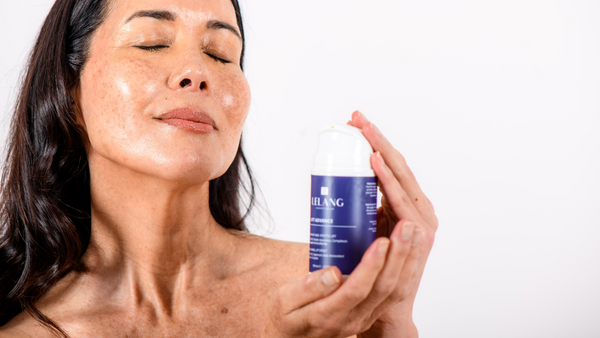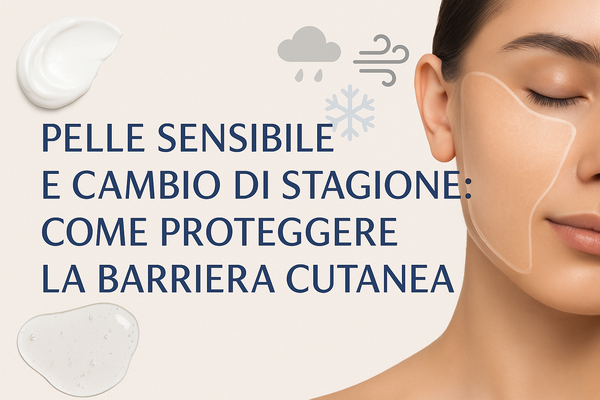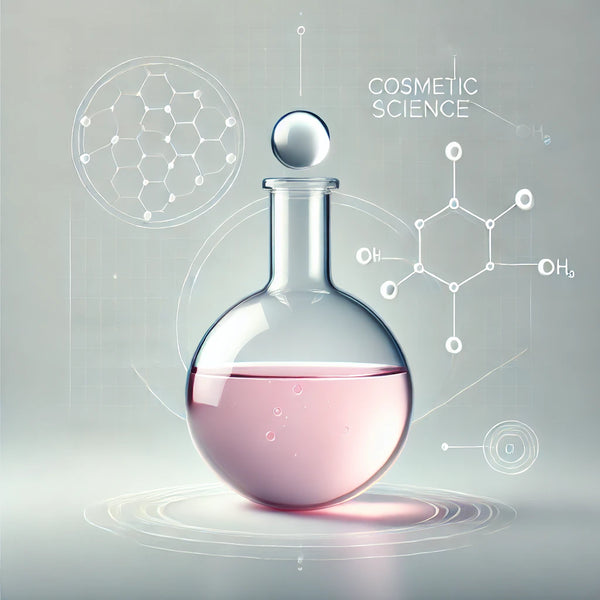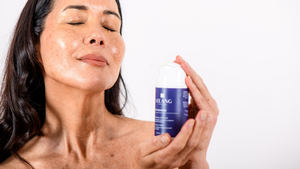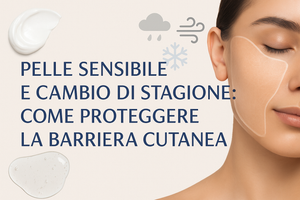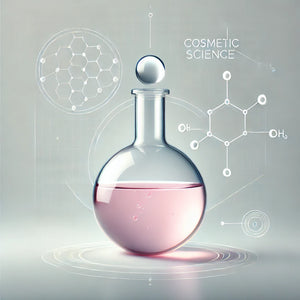Introduction
The change of season, especially between winter and spring or between summer and autumn, represents a significant biological challenge for the skin, particularly for those with sensitive or reactive skin. Environmental factors such as temperature fluctuations, wind, humidity variations, pollution, and UV radiation directly affect the functionality of the skin barrier, increasing the risk of dehydration, redness, inflammation, and discomfort.
Protecting the skin barrier during these periods means preserving the hydrolipidic balance, modulating the inflammatory response, and maintaining the cohesion between corneocytes intact. In this article, we will explore why the skin worsens in spring and autumn, which signs to observe, how to adapt the routine, and which dermofunctional actives are most effective to ensure protection and comfort. If you want a specific insight into the structure and functions of the skin barrier, we invite you to also read the dedicated article Skin Barrier: What It Is, Functions, and How to Repair It.
Why the skin worsens with the change of season
During seasonal transitions, the body is forced to adapt to new environmental conditions in a very short time. This is especially true for people with predisposed or already sensitized skin, as we also explain in the article What Sensitive Skin Is and How to Treat It. This also has a visible impact on the skin:
-
Temperature fluctuations: the transition between warm (indoor) and cold or windy (outdoor) environments disrupts skin thermoregulation and reduces the skin's ability to retain hydration.
-
Wind and dry air: accelerate the evaporation of surface water (TEWL), causing dryness, itching, and redness.
-
UV radiation: with increased daylight hours (especially in spring), more exposed skin is subject to oxidative stress and inflammation.
-
Air pollution: fine particles (PM2.5) penetrate the stratum corneum and alter the skin flora, worsening inflammatory manifestations.
-
Unstable microbiota: climate also influences the bacterial composition of the skin, making it less resistant and more prone to dysbiosis and irritation.
The biological mechanisms involved
The skin barrier is mainly composed of the stratum corneum, where a lipid matrix of ceramides, fatty acids, and cholesterol protects against external aggressions. During seasonal changes, this structure undergoes:
-
Increase in TEWL (transepidermal water loss)
-
Reduction of endogenous lipid synthesis
-
Activation of subclinical inflammatory responses
-
Decrease in skin antioxidant defenses
Studies published in Experimental Dermatology have shown that in subjects with sensitive or atopic skin, these mechanisms activate more intensely and earlier, predisposing the skin to erythema, desquamation, and persistent discomfort.
The most common symptoms of sensitive skin in spring and autumn
During seasonal transition periods, sensitive skin shows a series of typical signs reflecting a compromised skin barrier. These symptoms stem from hydrolipidic imbalances, alterations in skin flora, and increased inflammatory responses:
-
Sudden and persistent redness: mainly localized on cheeks, nose, and chin, caused by vasodilation and increased reactivity of skin capillaries to temperature fluctuations.
-
Itching, burning, and sensation of heat: triggered by barrier dysfunction, which can no longer effectively filter irritants or sensitizing substances.
-
Tight and generally dry skin: indicate excessive transepidermal water loss (TEWL), which makes the skin surface more fragile and prone to microfissures.
-
Fine desquamation or microcracking: especially in more exposed areas (cheekbones, forehead), where the skin struggles to maintain cellular cohesion due to lipid deficiency.
-
Increased reactivity to usual cosmetics: even products tolerated during other times of the year can cause discomfort, burning, or erythema.
-
Nighttime or post-cleansing itchiness: often linked to the breakdown of the hydrolipidic film that normally protects superficial nerve receptors.
These signs should not be ignored, as they are the clinical manifestation of a damaged and hyperreactive barrier. Targeted, preventive skincare that respects the skin's physiological balance is essential to manage them effectively and reduce the risk of chronicity. To learn more about the most common causes of skin redness, you can read the article Cause of Skin Redness: How to Protect Sensitive Skin.
-
Sudden redness, especially on cheeks and nose
-
Sensation of stinging, itching, or tight skin
-
Surface dryness despite the use of creams
-
Appearance of light flaking or microcracking
-
Increased reactivity to usual cosmetics
These signs indicate a weakened barrier and should not be ignored. Early intervention with functional actives and targeted cleansing can prevent worsening.
How to change skincare during the change of season
1. Gentle and balanced cleansing
Avoid harsh surfactants and prefer physiological cleansing mousses or oils. Double cleansing can help, provided it is well balanced: for example, Gentle Oil + Detox Mousse morning and evening.
2. Toning with hydrating and rebalancing actives
Using a thermal toner or a hyperthermal sulfurous water (such as that from Valdieri) can help strengthen the microbiota and immediately soothe redness and stinging.
3. Barrier cream with soothing actives
Recommended ingredients:
-
Biomimetic ceramides
-
Bisabolol
-
Medium molecular weight hyaluronic acid
-
Panthenol
-
Mallow, marshmallow, calendula
4. Targeted treatment in case of intense sensitization
A rebalancing serum can help during critical periods. Prefer formulations free of alcohol and fragrance, enriched with thermal waters and antioxidant actives.
Mistakes to avoid
-
Completely changing the routine from one day to the next
-
Using too many exfoliating actives (acids, retinoids)
-
Exposing yourself to the sun without protection during the first warm days
-
Applying occlusive makeup without a protective barrier underneath
The recommended LeLang protocol
To protect sensitive skin during seasonal changes:
-
Step 1: Gentle Oil + Detox Mousse
-
Step 2: Pro Age Thermal Water
-
Step 3 (day): Licoglow Serum – to provide radiance and antioxidant protection with a lightweight formula, also suitable for sensitive skin
-
Step 3 (evening): 5 Complex Serum – to strengthen the barrier and promote renewal with peptides and biotechnological actives
-
Step 4: Nutralight Sensitive Cream – to seal in hydration, soothe, and rebalance the skin barrier
Conclusion
The seasonal change represents much more than a simple climate variation: it is a real stress test for the skin, especially for those who suffer from skin sensitivity. During this transition, the skin must recalibrate its immune response, adapt to new environmental conditions, and maintain its functional barrier despite temperature fluctuations, pollution, and humidity changes.
A weakened skin barrier causes not only aesthetic discomfort but also increased susceptibility to inflammation, redness, and deeper dysfunctions. It is therefore essential not to improvise but to adopt intelligent skincare based on dermo-affine actives and protocols designed to support the skin in its defense and regeneration mechanisms.
Adapting the routine doesn't mean changing everything, but carefully choosing targeted, effective products tested on sensitive skin. The LeLang protocol proposed in this article combines high-tolerance actives with soothing thermal waters and biotechnological ingredients capable of acting on multiple fronts: hydration, protection, repair, and radiance.
Prevention is always better than cure: listening to your skin, recognizing early signs of a struggling barrier, and gently intervening is the secret to facing every seasonal change with balance and confidence.
FAQ: Frequently Asked Questions
What is the skin barrier?
It is the outermost layer of the skin, made up of dead cells (corneocytes) and a lipid matrix composed of ceramides, fatty acids, and cholesterol. Its role is to protect against external agents, retain hydration, and keep the skin healthy and balanced.
How to tell if you have a damaged skin barrier?
Typical signs include tight skin, itching, redness, flaking, and increased sensitivity to cosmetics. These symptoms indicate high TEWL and a loss of cohesion between corneocytes.
How is the skin barrier repaired?
It is essential to use skin-friendly products with ceramides, panthenol, hyaluronic acid, and thermal water. Avoiding aggressive actives, restoring hydration, and reducing sources of irritation are key steps.
What does it mean that the skin behaves like a lipophilic barrier?
It means that the skin has a lipid structure that repels water-soluble substances but absorbs liposoluble ones better. This is a natural defense mechanism, but if the barrier is altered, permeability can change.
1. Why does my skin always worsen in spring and autumn?
Because these periods involve temperature fluctuations, humidity changes, and increased exposure to pollutants and UV rays, all factors that stress the skin barrier.
2. How do I know if my skin barrier is damaged?
Common symptoms include redness, tight skin, itching, flaking, and reactivity to usual skincare products.
3. Can I use the same products all year round?
Not always. Seasonal changes require a recalibration of the routine, preferring more hydrating and soothing formulas during transition periods.
4. Should I stop using exfoliants?
In case of sensitized skin, it is advisable to reduce the frequency or temporarily suspend them to avoid further compromising the barrier.
5. Which active ingredients are most suitable?
Ceramides, bisabolol, panthenol, medium molecular weight hyaluronic acid, and soothing thermal waters such as the sulfurous one from Valdieri.
Scientific sources
-
Voegeli R. et al. (2020) – "TEWL variation and skin sensitivity", Experimental Dermatology
-
Proksch E. et al. (2008) – "The skin: an indispensable barrier", Experimental Dermatology
-
Elias PM. (2005) – "Stratum corneum defensive functions: an integrated view", Journal of Investigative Dermatology
-
Misery L. et al. (2016) – "Sensitive skin in dermatology: clinical, epidemiological and pathophysiological aspects"
-
Schikowski T. et al. (2019) – "Air pollution and skin aging: the role of particulate matter", Journal of Dermatological Science


